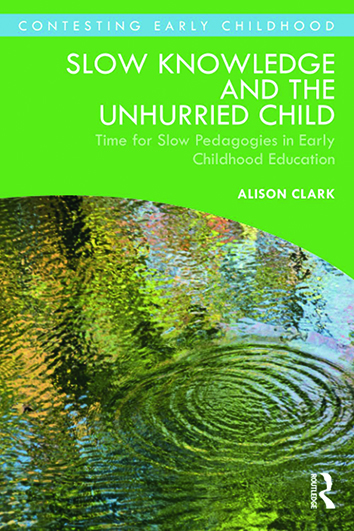
 There may be many reasons why young children can find their time in early childhood education and care divided into shorter and shorter fragments of play. This was one of the contrasts Mary Jane Drummond noticed in her reflections (2000) on reading the detailed accounts by Susan Isaacs about Malting House school: ‘In comparison with the primary classrooms where I have taught in the past and regularly observe today, there was no time wasted in the business of forming into lines, waiting in lines, completing the registers, collecting lunch money, searching for PE equipment – all the events that add up to evaporated time. All the available time was available for the children, not for the teachers’ routines; it was filled with the children’s dramatic, vivid lives.’
There may be many reasons why young children can find their time in early childhood education and care divided into shorter and shorter fragments of play. This was one of the contrasts Mary Jane Drummond noticed in her reflections (2000) on reading the detailed accounts by Susan Isaacs about Malting House school: ‘In comparison with the primary classrooms where I have taught in the past and regularly observe today, there was no time wasted in the business of forming into lines, waiting in lines, completing the registers, collecting lunch money, searching for PE equipment – all the events that add up to evaporated time. All the available time was available for the children, not for the teachers’ routines; it was filled with the children’s dramatic, vivid lives.’
Thinking with ‘timescapes’ makes space for acknowledging the experiential dimensions to time alongside the linear, timetabled, clock time. Povey et al. (2021) make the case for ‘regulated time’ as being identified with neoliberal schooling practices; [while] teaching that adopts ‘expansive time’ is prepared to make room for the unexpected and ‘unfinishedness’ where children can continue to build on and return to ideas. Drawing on the work of the curriculum theorist David Jardine, expansive time can be seen as ‘worthwhile time’ (2008, 2012, 2013). Jardine asks: ‘What makes some experiences worthy of rest and repose, worthy of returning, worthy of tarrying and remembering, of taking time, of whiling away our lives in their presence?’
The theologian John Swinton in his book Becoming Friends of Time (2016) discusses time and disability. He describes the time of the clock as being assumed to be linear, dynamic, forward facing, measurable and controllable.
‘Becoming friends with time’ suggests to me not being trapped by time or escaping time (timelessness) but of establishing a different relationship. This expansive view of time underlines the human and humane dimension to these discussions. It alerts us to the importance of our own personal histories in relation to how we value time, in the same way as I have discussed how the pandemic has impacted differently on individuals’ and families’ sense of time. During my interviews there were several moments when the personal nature of these inquiries about time became evident. I refer to two observations from Sylvia Kind here:
ALISON: So, what can slow look like? When you first read this, what did you think about? … what are the slow practices that you’ve come across in your own or others’ research?
SYLVIA: I wouldn’t necessarily have always called it slow, but that is the way I work. And it really, to me, has its roots not just in what I read but in my own early childhood experiences, to a beautiful Montessori School where one of my teachers, she retired when she was 90 years old, studied under Maria Montessori, and they had a full-time art teacher, and it was on a couple of acres right by the beach. And so we would do our Montessori work in the morning so that the afternoons were extended times outside painting at the beach, learning about the birds. So, that is always ingrained in me as a way of being an education. And I was there from pre-school through elementary years through grade three. And so it’s not just what I read, I think, it’s also what I experienced.
We see in Sylvia’s reflection how her early childhood experiences of education had a particular relationship with time, informed by a Montessorian approach that has had a deep impact on what she views education is about. Sylvia continued: ‘Probably and quite honestly, my best teacher in this has been my son Nathanial who was born with multiple disabilities and is nonverbal. Learning to walk to his rhythm, to notice the things he notices, and to learn his language and his diverse ways of communicating, of experiencing, and of being in this world, and his unique ways of attending to things, has shaped me more than anyone’s research.’
Learning to walk to Nathaniel’s rhythm illustrates what a time-full approach can look like with a different relationship to the clock. This is one in which it is recognised, as Swinton comments (2016), ‘each body holds its own time and each task moves to its own rhythm. Each task completed is the product of steady, purposeful, time-full action rather than frenzied, time-deprived drives for efficiency.’
Find out more about this book here









